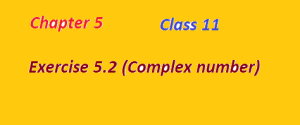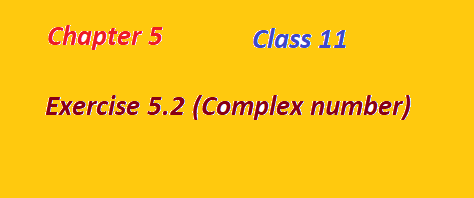Exercise 5.2 (Complex number)
Find the modulus and the arguments of each of the complex numbers in Exercises 1 to 2.(Exercise 5.2 complex no. ncert math solution class 11)

Question 1: ![]()
Solution : Let ![]()
Comparing the real and imaginary parts, we have
![]()
![]()
Squaring and adding equation (1) and (2), we have
![]()
![]()
![]()
Therefore, modulus ![]()
Now, dividing equation (2) by (1), we have
![]()
![]()
From the equations (1), (2) and (3), it is clear that ![]() and
and ![]() are negative but
are negative but ![]() is positive. So,
is positive. So, ![]() lies in III quadrant. Therefore,
lies in III quadrant. Therefore,
Argument ![]()
Question 2: ![]()
Solution : Let ![]()
Comparing the real and imaginary parts, we have
![]()
![]()
Squaring and adding equation (1) and (2), we have
![]()
![]()
![]()
![]()
Therefore, modulus ![]()
Now, dividing equation (2) by (1), we have
![]()
![]()
From the equations (1), (2) and (3), it is clear that ![]() and
and ![]() are negative but
are negative but ![]() is positive. So,
is positive. So, ![]() lies in II quadrant. Therefore,
lies in II quadrant. Therefore,
![]()
Convert each of the complex numbers given in Exercises 3 to 8 in the polar form:
Question 3: ![]()
Solution : Let ![]()
Comparing the real and imaginary parts, we have
![]()
![]()
Squaring and adding equation (1) and (2), we have
![]()
![]()
![]()
![]()
Therefore, modulus ![]()
Now, dividing equation (2) by (1), we have
![]()
![]()
From the equations (1), (2) and (3), it is clear that ![]() and
and ![]() are negative but
are negative but ![]() is positive. So,
is positive. So, ![]() lies in IV quadrant. Therefore,
lies in IV quadrant. Therefore,
![]()
Therefore, the polar form of ![]() is
is
![]()
Question 4: ![]()
Solution : Let ![]()
Comparing the real and imaginary parts, we have
![]()
![]()
Squaring and adding equation (1) and (2), we have
![]()
![]()
![]()
Therefore, modulus ![]()
Now, dividing equation (2) by (1), we have
![]()
![]()
From the equations (1), (2) and (3), it is clear that ![]() and
and ![]() are negative but
are negative but ![]() is positive. So,
is positive. So, ![]() lies in II quadrant. Therefore,
lies in II quadrant. Therefore,
![]()
Therefore, the polar form of ![]() is
is
![]()
Question 5: ![]()
Solution : Let ![]()
Comparing the real and imaginary parts, we have
![]()
![]()
Squaring and adding equation (1) and (2), we have
![]()
![]()
![]()
![]()
Therefore, modulus ![]()
Now, dividing equation (2) by (1), we have
![]()
![]()
From the equations (1), (2) and (3), it is clear that ![]() and
and ![]() are negative but tan
are negative but tan ![]() is positive. So,
is positive. So, ![]() lies in III quadrant. Therefore,
lies in III quadrant. Therefore,
![]()
Therefore, the polar form of ![]() is given by
is given by
![]()
Question 6: ![]()
Solution : Let ![]()
Comparing the real and imaginary parts, we have
![]()
![]()
Squaring and adding equation (1) and (2), we have
![]()
![]()
![]()
![]()
Therefore, modulus ![]()
Now, dividing equation (2) by (1), we have
![]()
![]()
From the equations (1), (2) and (3), it is clear that ![]() and
and ![]() are 0 but
are 0 but ![]() is negative. Therefore,
is negative. Therefore,
![]()
Therefore, the polar form of ![]() is
is
![]()
Question 7: ![]()
Solution : Let ![]()
Comparing the real and imaginary parts, we have
![]()
![]()
Squaring and adding equation (1) and (2), we have
![]()
![]()
![]()
![]()
Therefore, modulus ![]()
Now, dividing equation (2) by (1), we have
![]()
![]()
From the equations (1), (2) and (3), it is clear that ![]() and
and ![]() all are positive. So,
all are positive. So, ![]() lies in I quadrant. Therefore,
lies in I quadrant. Therefore,
![]()
Therefore, the polar form of ![]() is
is
![]()
Question 8: ![]()
Solution : Let ![]()
Comparing the real and imaginary parts, we have
![]()
![]()
Squaring and adding equation (1) and (2), we have
![]()
![]()
![]()
![]()
Therefore, modulus ![]()
Now, dividing equation (1) by (2), we have
![]()
![]()
![]()
From the equations (1), (2) and (3), it is clear that ![]() and
and ![]() are 0 but
are 0 but ![]() is positive. Therefore,
is positive. Therefore,
![]()
Therefore, the polar form of ![]() is given by
is given by
![]()

